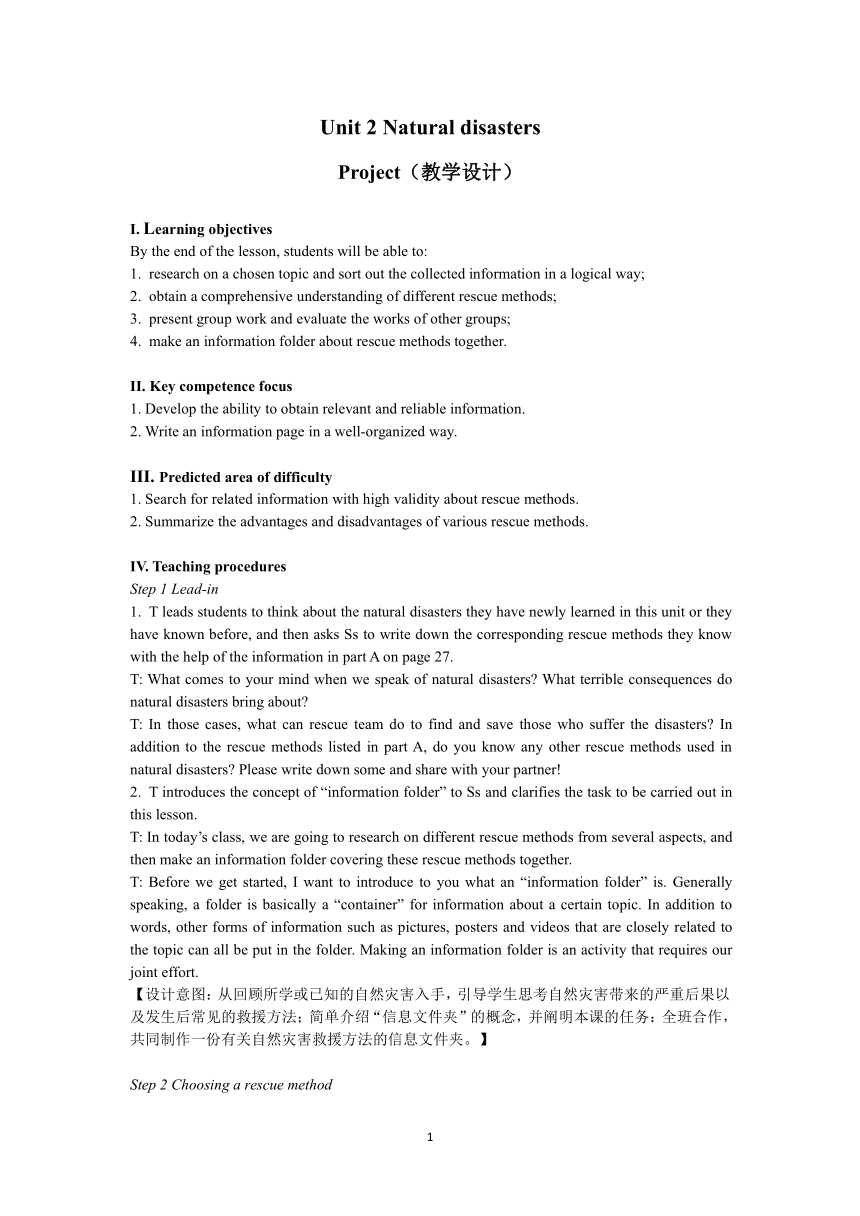
Unit 2 Natural disasters Project(教学设计) I. Learning objectives By the end of the lesson, students will be able to: research on a chosen topic and sort out the collected information in a logical way; obtain a comprehensive understanding of different rescue methods; present group work and evaluate the works of other groups; make an information folder about rescue methods together. II. Key competence focus 1. Develop the ability to obtain relevant and reliable information. 2. Write an information page in a well-organized way. III. Predicted area of difficulty 1. Search for related information with high validity about rescue methods. 2. Summarize the advantages and disadvantages of various rescue methods. IV. Teaching procedures Step 1 Lead-in T leads students to think about the natural disasters they have newly learned in this unit or they have known before, and then asks Ss to write down the corresponding rescue methods they know with the help of the information in part A on page 27. T: What comes to your mind when we speak of natural disasters What terrible consequences do natural disasters bring about T: In those cases, what can rescue team do to find and save those who suffer the disasters In addition to the rescue methods listed in part A, do you know any other rescue methods used in natural disasters Please write down some and share with your partner! T introduces the concept of “information folder” to Ss and clarifies the task to be carried out in this lesson. T: In today’s class, we are going to research on different rescue methods from several aspects, and then make an information folder covering these rescue methods together. T: Before we get started, I want to introduce to you what an “information folder” is. Generally speaking, a folder is basically a “container” for information about a certain topic. In addition to words, other forms of information such as pictures, posters and videos that are closely related to the topic can all be put in the folder. Making an information folder is an activity that requires our joint effort. 【设计意图:从回顾所学或已知的自然灾害入手,引导学生思考自然灾害带来的严重后果以及发生后常见的救援方法;简单介绍“信息文件夹”的概念,并阐明本课的任务:全班合作,共同制作一份有关自然灾害救援方法的信息文件夹。】 Step 2 Choosing a rescue method T leads Ss to choose a rescue method and figure out the detailed aspects of the chosen topic. In groups, T asks Ss to discuss different rescue methods they have listed in Step 1 and then choose one that interests them most to research on. After choosing a rescue method, T asks Ss to go through relevant aspects listed in part B and leads them to think about additional aspects that they want to do further research on. 【设计意图:在Step 1的头脑风暴结束后,让学生以小组的形式共同讨论,选择最感兴趣的话题进行探究。然后结合教材提供的探究视角,请学生发散思维,补充其他感兴趣的方面。这样学生可以有针对性地从多种角度分析、讨论救援方法,进而明白要构成一个信息文件夹需要放入哪些 ... ...
~~ 您好,已阅读到文档的结尾了 ~~